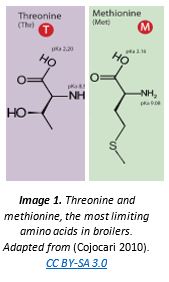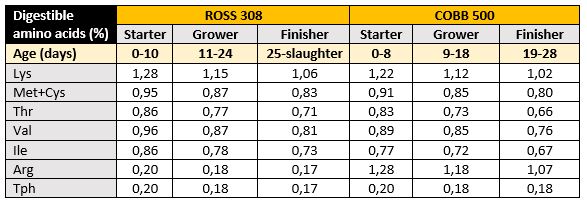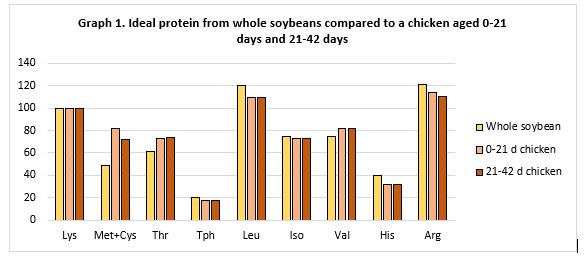Amino acids: definition and classification
Amino acids are organic compounds that form proteins. They also have other essential functions related with nervous transmission or the synthesis of other compounds that are essential for the organism. Their structure has the amino (-Nh2) and carboxyl (-COOH) functional groups.
Amino acids can be classified depending on whether the organism can synthesize them or not. Essential amino acids are the ones that cannot be synthesized and need to be included in the diet. Other amino acids, despite they are not essential, the organism cannot produce enough of them, hence they need to be supplied with the diet, too.
Essential amino acids for broiler chickens are lysine, methionine, threonine, tryptophan, isoleucine, histidine, valine, phenylalanine, and arginine. Glycine can be considered essential in young broilers, and cysteine and tyrosine are considered semiessential, since they can be synthesized from methionine and phenylalanine, respectively (Ravindran 2014). The most limiting amino acids are methionine and threonine, which means that their inclusion levels in the diet need to be meticulously evaluated.

Amino acid requirements in broilers
Amino acid requirements vary depending on the breed and growth stage. They are usually expressed as total and or digestible amino acids. It is highly recommended to use the latter, as it considers the final availability of these compounds, which is the amount of amino acid that will reach the organism after it is absorbed in the digestive tract.
Table 1. Amino acid requirements for two broiler commercial lines.

Feed formulations based on ideal protein
Feed formulas used in poultry production are increasingly centered in the ideal protein, a parameter that considers the exact amino acid supply to meet the maintenance and growing requirements of birds. This means that these diets supply the exact amount of each amino acid, so that none of them is administered in excess compared to the others. In short, the diet’s amino acid profile is completely adjusted to what animals need.
This change is caused by three main reasons: the increasing price of protein sources compared to energy sources, the greater availability of synthetic amino acids and, in some countries, the limitation of nitrogen excretion in the environment, as ideal protein optimizes nitrogen utilization.
Steps to formulate diets based on ideal protein
The protein-based ingredients have an amino acid profile that can be more or less similar to the bird’s requirements, but there is no ideal ingredient in terms of the amino acid profile, so the only way to meet the requirements in an exact manner is to use industrial amino acids. To do so, follow these steps:
- Use high-quality protein-based ingredients with an amino acid profile that is similar to the animal’s requirements. The nutrient composition of these ingredients must be known before making the feed formula.
- Supplement the feed with industrial amino acids until all the requirements are met.

How can we help you?
In Delta Labs, we offer the feed formulation and analysis service to evaluate and optimize the diets’ amino acid supply and adjust it to the ideal amino acid profile for the target species. This way, we help to optimize productive performance at the minimum cost.
To use the service, please contact us through our webpage www.globalvetslab.com or email at info@globalvetslab.com
Bibliography
Cobb-Vantress. 2018. “COBB 500 Broiler Performance & Nutrition Supplement.” : 10.
Cojocari, Dan (Princess Margaret Cancer Centre University fo Toronto). 2010. “[Picture] Amino Acids.” Wikipedia – Amino Acids. https://ca.wikipedia.org/wiki/Aminoàcid#/media/Fitxer:Molecular_structures_of_the_21_proteinogenic_amino_acids.svg (July 6, 2021).
Kalinowski Echegaray, Juan. 2005. “La Soja Integral En La Alimentación Avícola.” : 1–12. http://www.wpsa-aeca.es/aeca_imgs_docs/05_06_51_SojaIntegral.pdf.
Ravindran, Velmurugu. 2014. “Disponibilidad de Piensos y Nutrición de Aves de Corral En Países En Desarrollo.” Organización de las Naciones Unidas para la alimentación y la agricultura. Revisión del desarrollo agrícola.: 1–5. http://www.fao.org/3/a-al703s.pdf.
“ROSS Especificaciones de Nutrición.” 2019. : 4. https://es.aviagen.com/assets/Tech_Center/BB_Foreign_Language_Docs/Spanish_TechDocs/RossBroilerNutritionSpecs2019-ES.pdf.